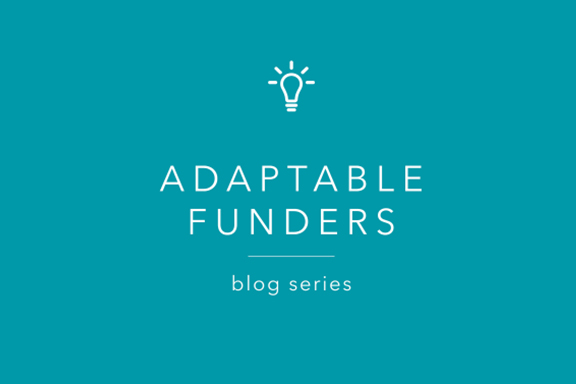
Prior to 2020, foundations and other funders were already working on improving the way philanthropy was conducted. Then came COVID-19 and the social rupture driven by centuries of racial inequity and social injustice, and the need to do better could not be ignored. Across philanthropy’s landscape, some funders have stood out for how quickly and successfully they pivoted in crisis response. By sharing their stories in our Adaptable Funder blog series, we are highlighting practices that existed prior to recent crises that enabled flexibility, and lessons learned since that any funder can adopt to be more effective and resilient going forward.
Karen Voci, president of the Harvard Pilgrim Health Care Foundation for more than 14 years, shared the evolution of the Foundation’s thinking and programming for our blog back in 2019 after the Foundation underwent a strategic planning process led by TPI. Now, Karen speaks to how those shifts were critical to the Foundation’s quick response to COVID-19 in the four New England states it serves and in its work as 2020 progressed. Funders of all types will find value in the best practices she outlines, and health funders, in particular, may want to consider Voci’s thoughts on areas of potential as they, too, look to the future. (Note at the time of publication: With the combination of their parent organizations, Harvard Pilgrim Health Care Foundation is in the process of combining with the Tufts Health Plan Foundation.)
—
TPI: If a funder wanted to adopt three key practices that strengthen everyday philanthropy, and that prove essential in crisis response, what lessons would you offer?
First, we have a strategic plan that defines us. The process we underwent with TPI a few years ago enabled us to figure out our niche, and when we did, we became initiative driven. We look for small, local, grassroots organizations tackling issues we care about. Our grantmaking has always been about building healthy communities, and over time we realized the issues we wanted to focus on most were healthy food and healthy aging. Find your niche and work it with everything you have.
Second, our commitments are more than money. We partner with nonprofit organizations to help boost their capacity to do what they do better. Because we fund them for three years, our team (with only two full-time staff) doesn’t spend time on evaluating proposals each year. Instead, we identify ways to leverage the full array of resources at our disposal to strengthen the work of our grantee partners – our people, volunteers, webinars, connections to key stakeholders, and more. We also do in-person site visits. Seeing and hearing what is happening first-hand is invaluable.
When COVID-19 hit, we could respond quickly because we know our grantees so well, like family. One example is that within a week and a half, we sent out a one-page application for additional funds to grantees, reviewed requests, and sent them more money to assist in COVID response in their community.
At the same time, the chairman of our board (and then president/CEO of Harvard Pilgrim Health Care) was eager for us to create a prepared meal delivery program. We reached out to our nonprofits in the hardest-hit communities in our four-state region, and they reached out to restaurants and caterers. We trusted them to choose whom to work with because they’re not just people we fund, they are our partners. Within two weeks, we had restaurant workers employed cooking meals in and for the communities our grantees serve.
In addition, as part of our Healthy Aging Initiative, we work with providers who run “Train the Trainer” programs. For example, Matter of Balance focuses on preventing falls and building strength, and Savvy Caregiver provides support to caregivers. We helped move their programs online, and the positive results surprised us. Since people couldn’t leave their houses, the online programs still connected them. They socialized. The time commitment was less since they didn’t need to travel. Savvy Caregiver drew more people to their groups, and Matter of Balance in Maine ran its first virtual pilot. The virtual option may continue long past the pandemic.
Third, our application process is far less complicated and more streamlined than those of many other foundations. By writing short applications and providing comprehensive communications on the front end, we have found this is as effective as requiring multiple steps. Being in philanthropy used to be more like investigative journalism, and it became a great deal of office-based data management. We want to spend our time in active service to the projects we fund and eliminate barriers to accessing funding. For example, we wanted to get $1 million to community-based organizations in Black, Brown, and Indigenous communities in the region for COVID-19 vaccination education. It took less than three weeks from the time we decided to do this, put out the one-page application, and selected grantee partners to fund. I hope responding more rapidly to emerging needs is one thing that stays with us post-pandemic. The more we move funds with intentionality, the faster we have an impact.
TPI: As a health funder, your COVID-19 response was a clear extension of your ongoing work. How did Harvard Pilgrim Foundation react to last summer’s racial and social unrest?
I was gobsmacked. Even though I know that some of my colleagues live with racism every day, it was a real reckoning for me personally. We have a multicultural team, and the Foundation supports a good number of diverse programs, yet I had to ask myself, “Why haven’t we been calling this out?” As a team, we decided to ask for proposals from organizations serving Black and Brown youth, 21 and under, through a grant program we called “Healthy Youth, Healthy Community.” We did quick applications, met with the top applicants virtually, and we were inspired to find out about the extraordinary work being done by young leaders of color, under the radar. We ended up giving $20,000 each to six youth-driven organizations instead of the five we had planned on. They were already doing the work. We saw our job as helping them propel their work forward faster and supporting them any way we could.
During this time, it also became even more clear to us that some of the biggest determinants of health are food and housing. If you look at housing in impoverished communities, particularly in communities of color, you know why a place like Chelsea was the epicenter of the pandemic in Massachusetts. And it’s become clear that our healthcare system does not provide adequate medical care for people who are impoverished. Massachusetts has taken important steps, but more needs to be done across the country on cost and availability. One thing we did last fall was contribute $1 million to the Massachusetts-based Community Care Cooperative’s campaign to increase telehealth capacities for its network of community health centers.
TPI: What do you see as short-term and long-term impacts of COVID on philanthropy?
COVID did heighten the need to be ready to provide immediate response, in our case around healthy food or telehealth. And our work in telehealth will have long-term impact. We’ve been in the middle of the healthy food issue for a while, and everyone now sees that our food system is very vulnerable. Health philanthropy needs to spend time on that. Our newly combined organization has a lot of opportunities and a deep bench, so I’m very optimistic about what lies ahead for us.
For every funder, there is something to be said for placing your bets on organizations you think are achieving goals your foundation wants to achieve, and then staying with them. Know where you can make the most contributions and follow those guidelines of finding capable partners you trust and who will trust you. Go there. We did site visits even last summer, socially distanced. We went with board members, bought everyone boxed lunches. Sit with people, offer your skills – not just your organization’s but yours.
Then, in going local, connect what you do to a bigger moment. Philanthropy can do that, make that connection to the larger purpose. What is the end game? Ours has been to renew the importance of food systems, make it local, affordable, so people can live healthier lives. In some cases, the larger picture, the ability to see opportunities for systems change, is not quite yet emerging. COVID set that back. This is where a funder can have impact – working to connect the local issue to the larger picture, to find ways to make lasting contributions.
TPI: So, what lies ahead for health philanthropy in particular?
Looking across the field, I think health philanthropy may be leading the way within the field of philanthropy. It’s a real place for substantive philanthropic strategies focusing on progressive social policy. We’ve made some inroads, but there are plenty of opportunities for philanthropy to do more to move policy forward and address critical long-term gaps and disparities. Wage equity, affordable housing, and other issues are part and parcel of health, too. We all need to realize there’s a larger definition of health we need to contend with. Nobody can do everything. For many funders, it’s one major focus and possibly one minor focus, at most, but COVID has shown us that everything interrelates – and where new or stronger areas of focus need to be.


